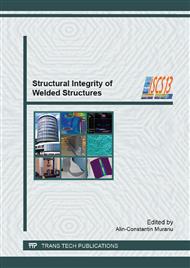p.7
p.19
p.25
p.33
p.41
p.49
p.54
p.60
p.68
Structural and Mechanical Characterization of Hard Layers Obtained by Plasma Jet Thermal Spraying
Abstract:
In many countries, in the industrial practice, the hard layers deposition is used to increase the hardness of the components active zones. A viable solution to increase the imposed properties consists in the deposition of amorphous layers by thermal spraying. Ferroalloy powders were deposited by plasma jet thermal spraying on aluminium substrates in order to increase the hardness. By plasma jet thermal spraying of Fe-B, Fe-Ni-B and Fe-Cr-Mn-Mo-W-B-P-Si powders on aluminum supports, have been obtained hard layers having the thickness between 72 μm and 86 μm, and granular structures made from α solid solutions, fine particles of specific oxides and complex particles of Fe-B, Fe-B-Si, Fe-Cr, Fe-W-Mo and Fe-P. The measured hardness had the values between 383 and 391 HV1 for the deposited layers made from powders type Fe-B, the values between 410 and 420 HV1 for the deposited layers made from powders type Fe-Ni-B, and the values between 448 and 475 HV1 for the deposited layers made from powders type Fe-Cr-Mn-Mo-W-B-P-Si. No defects, such as cracks or microcracks, have been observed on the hard layers surfaces deposited by plasma jet thermal spraying.
Info:
Periodical:
Pages:
41-48
Citation:
Online since:
September 2013
Authors:
Price:
Сopyright:
© 2013 Trans Tech Publications Ltd. All Rights Reserved
Share:
Citation:


